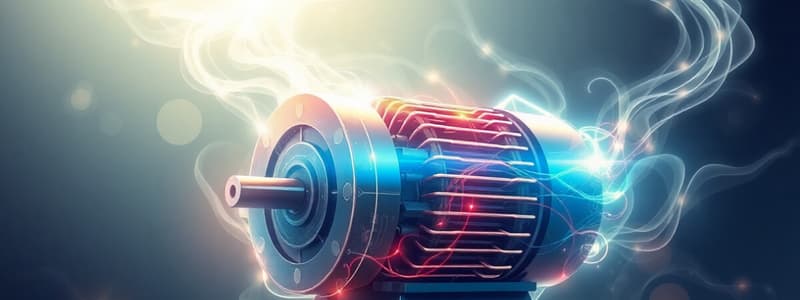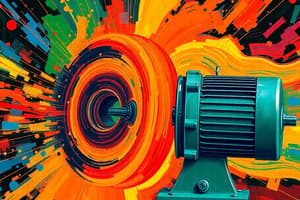Podcast
Questions and Answers
What is one of the advantages of a single-phase induction motor?
What is one of the advantages of a single-phase induction motor?
- High efficiency of about 95-97%
- Self-starting capability (correct)
- Develops maximum torque like a 3-phase motor
- Low power factor of around 0.4 to 0.5
Which characteristic differentiates a 3-phase induction motor from a single-phase induction motor?
Which characteristic differentiates a 3-phase induction motor from a single-phase induction motor?
- Uses a balanced single-phase AC supply
- Develops lower torque
- Has one set of three-phase windings (correct)
- Requires auxiliary circuits for starting
What is a common disadvantage of single-phase induction motors?
What is a common disadvantage of single-phase induction motors?
- Higher efficiency compared to 3-phase motors
- Requires no special circuits for self-starting
- Compact design suitable for industrial applications
- Increased vibrations and noise due to torque pulsations (correct)
What is the typical power factor range for a single-phase induction motor?
What is the typical power factor range for a single-phase induction motor?
During start-up, how does the current drawn by a single-phase induction motor compare to a 3-phase motor?
During start-up, how does the current drawn by a single-phase induction motor compare to a 3-phase motor?
What limitation does a single-phase induction motor have concerning maximum torque?
What limitation does a single-phase induction motor have concerning maximum torque?
What is the suitable application for a single-phase induction motor?
What is the suitable application for a single-phase induction motor?
Which factor contributes to lower efficiency in single-phase induction motors?
Which factor contributes to lower efficiency in single-phase induction motors?
Which statement about the construction of a single-phase induction motor is true?
Which statement about the construction of a single-phase induction motor is true?
Which advantage is often claimed about the construction of a single-phase induction motor?
Which advantage is often claimed about the construction of a single-phase induction motor?
Which theory describes the behavior of torque production in single-phase induction motors?
Which theory describes the behavior of torque production in single-phase induction motors?
What characteristic of the magnetic field does the term 'pulsating' refer to?
What characteristic of the magnetic field does the term 'pulsating' refer to?
What starting mechanisms are required for single-phase induction motors to operate?
What starting mechanisms are required for single-phase induction motors to operate?
Which type of single-phase induction motor uses conductor shading to create a phase difference?
Which type of single-phase induction motor uses conductor shading to create a phase difference?
What component is essential in a capacitor start motor for improving starting torque?
What component is essential in a capacitor start motor for improving starting torque?
What causes the rotor of a single-phase induction motor not to start spinning on its own?
What causes the rotor of a single-phase induction motor not to start spinning on its own?
Which circuit model is used to study the dynamic behavior of single-phase induction motors?
Which circuit model is used to study the dynamic behavior of single-phase induction motors?
What is a common application of single-phase induction motors?
What is a common application of single-phase induction motors?
Which motor type provides maximum starting torque with dual capacitors?
Which motor type provides maximum starting torque with dual capacitors?
In the equivalent circuit of a single-phase induction motor, which component represents the stator?
In the equivalent circuit of a single-phase induction motor, which component represents the stator?
What is a defining characteristic of a single-phase induction motor's rotor?
What is a defining characteristic of a single-phase induction motor's rotor?
Why does a single-phase induction motor not self-start?
Why does a single-phase induction motor not self-start?
What type of magnetic field is produced when a single-phase supply energizes the stator winding?
What type of magnetic field is produced when a single-phase supply energizes the stator winding?
What starting method is commonly used for single-phase induction motors due to their inability to self-start?
What starting method is commonly used for single-phase induction motors due to their inability to self-start?
In which applications are single-phase induction motors most frequently used?
In which applications are single-phase induction motors most frequently used?
What additional means can help the rotor of a single-phase induction motor to start?
What additional means can help the rotor of a single-phase induction motor to start?
What is one primary reason for the popularity of single-phase induction motors?
What is one primary reason for the popularity of single-phase induction motors?
What happens to the magnetic field in a single-phase induction motor when the supply is energized?
What happens to the magnetic field in a single-phase induction motor when the supply is energized?
In what way does the construction of a single-phase induction motor differ from that of a three-phase induction motor?
In what way does the construction of a single-phase induction motor differ from that of a three-phase induction motor?
What component is crucial for the operation of a single-phase induction motor?
What component is crucial for the operation of a single-phase induction motor?
Flashcards are hidden until you start studying
Study Notes
Single Phase Induction Motor
-
A single phase induction motor uses a single-phase winding on the stator and a cage winding on the rotor.
-
When the stator winding is powered, it produces a pulsating magnetic field:
-
The magnetic field increases in one direction, decreases to zero, and then increases in the opposite direction.
-
This field does not produce a starting torque, so single-phase induction motors are not self-starting.
-
-
The rotor needs an external force to start rotating. Once rotating, the motor operates similarly to a three-phase motor.
-
The motor's performance is best understood using the Double Revolving Field Theory or the Cross Field Theory.
Construction
-
The stator is the stationary part that creates the magnetic field.
-
The rotor is the rotating part inside the stator.
-
It is typically a squirrel cage rotor made of aluminum/copper bars short-circuited by end rings.
Double-Revolving Field Theory
-
A single-phase supply creates two equal magnetic fields rotating in opposite directions.
-
These fields cancel out, generating a pulsating magnetic field.
-
No torque is produced by this pulsing field.
-
When the rotor starts rotating, it experiences a leading field first and then a lagging field.
-
This generates an electromotive force (EMF) in the rotor conductors, creating a current.
-
This interaction produces a starting torque, enabling self-starting.
Single Phase Induction Motor is not Self-Starting
-
The pulsating magnetic field doesn't create a torque large enough to start the motor.
-
The rotor experiences equal and opposite torque from the field, resulting in no net starting force.
-
To overcome this, techniques like split phase, shaded pole, and capacitor start are used, adding a phase difference to the fields.
-
This converts the pulsating field into a quasi-rotating one, enabling self-starting.
Types of Single Phase Induction Motor
-
Split Phase Motor: Two windings with different resistances create a phase difference for starting.
-
Shaded Pole Motor: A secondary winding (shading coil) wrapped around part of the pole delays the magnetic flux for that part, introducing a phase lag.
-
Capacitor Start Motor: Adds a starting capacitor in series with the auxiliary winding for better starting torque.
-
Permanent Split Capacitor Motor: Runs continuously with a capacitor for starting and running.
-
Capacitor Start Capacitor Run Motor: Uses two capacitors, one for starting and one for running, to maximize torque in both modes.
Applications of Single Phase Induction Motor
-
Commonly used in household appliances (fans, blenders, grinders), commercial equipment (refrigerators, water pumps), and light industrial tools (woodworking, metalworking), and small industrial applications.
-
Suitable for applications requiring frequent starts/stops with reasonable starting torque.
Advantages of Single Phase Induction Motor
-
Economical and inexpensive to build.
-
Self-starting with direct connection to single-phase supply.
-
Rugged and maintenance-free rotor.
-
Compact and lightweight.
-
Speed control through external resistors.
-
Widely available.
Disadvantages of Single Phase Induction Motor
-
Develops less torque than a three-phase motor.
-
Low power factor.
-
Higher vibration and noise.
-
Lower efficiency.
-
Requires special circuits for self-starting, increasing cost and size.
Difference Between 3-Phase and Single Phase Induction Motor
-
3-Phase Induction Motor:
-
Uses a balanced 3-phase AC supply.
-
One set of 3-phase windings.
-
Self-starting.
-
High power factor (near unity).
-
Higher torque.
-
Higher efficiency.
-
Industrial applications.
-
-
1-Phase Induction Motor:
-
Uses a single-phase AC supply.
-
Two windings (one for starting, one for running).
-
Requires auxiliary circuits for starting.
-
Low power factor.
-
Lower torque.
-
Lower efficiency.
-
Household and light industrial applications.
-
Studying That Suits You
Use AI to generate personalized quizzes and flashcards to suit your learning preferences.





